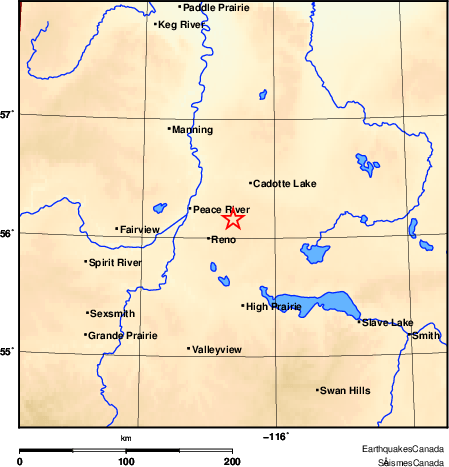The 5.8 magnitude earthquake that happened near Reno and Peace River Tuesday night was the strongest earthquake recorded in Alberta since modern instrumentation.
Natural Resources Canada Seismic Analyst Joseph Farrugia explains the exact magnitude could be slightly changed as the event is analyzed. Not only is Natural Resources Canada looking into it but the scientific community at large because of its significance.
Farrugia says one of the main questions he has heard is whether the earthquake was a result of industrial activity like oil and gas exploration. He explains that when seismic events happen Natural Resources Canada communicates with the provincial regulator, and their assessment so far is that there is no evidence the earthquake is related to industrial activity.
“For the moment we are considering these natural tectonic earthquakes,” Farrugia says. “They are just like earthquakes that happen anywhere else in the world. On the west coast in British Colombia, we have lots of earthquakes. That’s generally because we are where two tectonic plates meet and so it generates a fair bit of seismicity.”
However, Farrugia explains Alberta is in a continental plate which means no two plates are rubbing together to cause a seismic event. Instead, there are crustal faults that were created over time by geologic histories like mountain building processes or other tectonic events, creating faults that remain underground.
Farrugia says these faults can remain under the earth for a long time and not produce any earthquakes.
“But, over time the little strains and the little pressures that are coming from all sides of the continent are putting pressure on those faults, and if that accumulated strain is so much that it is enough to release the fault and let it slip that’s when it generates an earthquake. That is what we think happened in this case.”
Because of the significance this earthquake has, both in terms of its size and the historical impact it has on the province, there will be a deeper research investigation done over the following months. Farrugia explains that the investigation should answer questions like how the earthquake happened, what fault it occurred on, and other finer details.
“What I know right now from some preliminary results is that this was a shallow crustal earthquake and it was a thrust faulting earthquake. That’s the type of earthquake mechanism and from preliminary results is this generated as much as about four centimetres of ground surface deformation.”
Farrugia says this all shows that earthquakes of this size are possible in the Peace Country. Based on preliminary estimates, the recurrence rate of earthquakes of this size is 150 years. That doesn’t mean it will take 150 years for the next earthquake to happen, but that number represents on average the rarity of the occurrence of these events.
The last earthquake close to this magnitude in the province was in 2001 and was on the B. ..Alberta border near Dawson Creek. That earthquake 20 years ago recorded a 5.3 magnitude. However, Farrugia says there is a lot of uncertainty around the 150-year number as there is not enough data on earthquakes in Alberta.
“This serves as a good reminder this is earthquake country in Alberta. You know you are close to the Rocky Mountains, and there are faults associated with those that are in the Western Canadian Sedimentary Basin, where a lot of Alberta lives, and these are possible,” Farrugia says. “So I think it is a good reminder that earthquakes can occur in this area and people should start thinking about earthquake preparedness and steps they can do to be more earthquake resilient.”
He adds if anyone felt the earthquake but hasn’t reported it yet they are encouraged to do so on the Earthquakes Canada website,. That information is helpful when it comes to not only research but also improving the national building code when it comes to things like seismic response.



